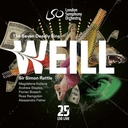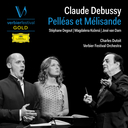Mahler to remember closes the Berliner Philharmoniker and Sir Simon Rattle's London residency
Sir Simon Rattle and the Berliner Philharmoniker brought their London residency to an end with two performances of Mahler’s Symphony no. 2, “Resurrection” at the Royal Festival Hall. Two performances of such a visceral, mammoth work is a challenge in itself, but coming at the end of a packed week including a three concert Sibelius cycle, one would have thought the Berlin players would have nothing left to give. However, the audience was not let down, and we were rewarded with a performance to be remembered for some time to come.
They began with a short work by German composer Helmut Lachenmann. Lachenmann studied with Luigi Nono, and later became a significant presence at Darmstadt. He describes his compositions as “musique concrète instrumentale”, and his music draws on a whole range of extended techniques, producing often unusual and unexpected timbres. In Tableau for orchestra, we hear frequent use of breath, for example, with wind and brass players producing sound effects by breathing into their instruments. This is often combined with extensive use of a broad range of percussion, again often making breathy, sweeping sounds. This is music that requires precision and immense control, and Rattle steered the Berlin musicians through the challenging soundscape with confidence. the orchestra's response was technically impressive.
From the very beginning of the Mahler, it was clear that this would be a committed performance, with the cellos and basses giving a full-on physical attack to their opening statement, and later in the movement, the double basses’ col legno in particular was positively violent. The violins demonstrated their rich, silky sound, and the brass section showed off their warm tone too. Throughout, there was total commitment from the players, matched by an intensity of energy and focus from Rattle, conducting without the score. The antiphonally placed violins led to one or two moments of the slightest lack of ensemble between the back desks of strings at either side of the stage, but these moments were fleeting.
The second movement was played with the utmost grace and poise, and the string ensemble was tight here. In the third movement, the antiphonal effect of the violins came into its own, although there was also one dangerous moment of shaky ensemble, when the split first violins and cellos are playing with the clarinet, then suddenly drop out leaving a solo violin and the flute to take over. However, the moment passed, and the desperate climax which heralded the entrance of Magdalena Kožená for “Urlicht” was highly dramatic. Kožená, standing behind the violins stage right, had immediate commanding presence, and hers was intimate and touching singing, her rich mezzo voice projecting over the orchestra beautifully. Her final “Leben” hung in the air, and then she was gone again.
The finale has a long, slow build, with frequent dramatic episodes, which Rattle controlled perfectly. There is so much going on here, with the frequent off-stage brass and percussion sections, each time positioned differently backstage – one suspects there was a fair bit of running down corridors required of the performers. Once again, there was total commitment from the players, with numerous assured wind solos, and the brass chorale built to a glorious explosion. The truly frightening drum crescendo was yet another example of the extreme intensity Rattle required of the orchestra – no half measures here.
The choruses have such a tough job – after over an hour sitting waiting, they are required to sing incredibly quietly, unaccompanied and usually (as here) still seated. The combined forces of the London Symphony Chorus and the City of Birmingham Symphony Chorus, singing from memory, began with a solid pianissimo, and remained within a hair’s breadth of being in tune for the entry of the soprano and orchestra. Every word was given clear diction, and powerful intent. Kate Royal and Magdalena Kožená, again stage right behind the orchestra, gave strong performances, and their positioning gave a real sense to the fugal entries they begin and hand over to the chorus for final section. Here, the choral focus and precision was stunning, with every word still crystal clear, with total commitment and energy for their final climax. The conclusion of the symphony is really beyond description in words, such a sublime affirmation, and it was clear that every musician gave this all they had. During the well-deserved standing ovation which followed, Rattle worked his way through pretty much the whole orchestra, but gave particularly warm thanks to the double basses.
This was certainly a performance to remember, and a fitting conclusion to a triumphant residency from Sir Simon and the Berliner Philharmoniker.
© Nick Boston



